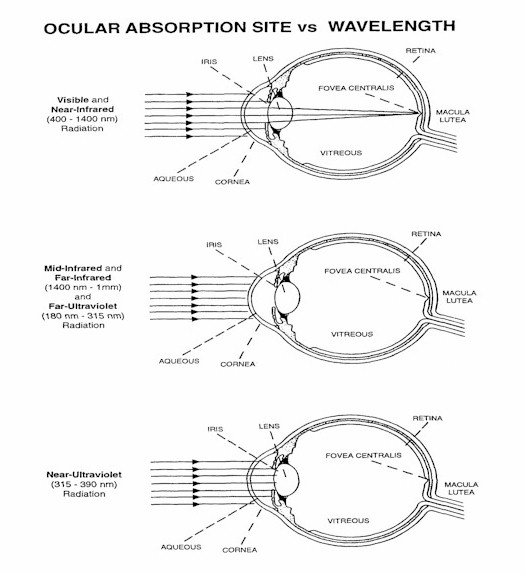In the time that it takes to blink an eye, laser radiation damage to the eye may have already occurred. Unprotected exposure to lasers can result in the development of cataracts or even a corneal burn, which can result in vision loss. If you are working with or around lasers, it is very important to understand the consequences of laser radiation exposure. We have decided to dedicate this post to educating you about laser beams and the safety precautions you should take when working around them.
Laser Beam Exposure
In addition to direct laser beam exposure, there are several other types of dangerous indirect laser beam exposures. Intra beam exposure occurs when the eye or skin is directly exposed to all or a part of the laser beam. It is also important to be careful of specular reflections. This is when the laser beam is reflected off mirror like surfaces. Reflections from flat mirror surfaces can be as harmful as exposure to a direct laser beam. Curved mirror surfaces decrease the intensity of the beam, but there is a larger area for possible laser radiation exposure. Diffuse reflections happen with surfaces that reflect the beam in many directions. Because the beam is reflected in so many directions, this exposure does not have the same power and energy of a direct beam. It is important to keep in mind that diffuse reflections are still harmful.
Protecting Your Eyes
The biggest risk with working around lasers is having any of these types of exposures enter the eye unprotected. In the human body, the eye is the most sensitive to light. When the eye is exposed to a laser beam, the lens in the eye focuses the beam into a tiny spot. This can actually burn the retina of the eye. At different wavelengths, lasers cause several types of eye injuries. Exposure to laser radiation with wavelengths that are less than 400 nanometers and greater than 1400 nanometers result in cataracts and burn injuries. This is because the eye absorbs this level of exposure through the cornea and lens. The most damaging wavelengths are between 400 and 1,400 nanometers, which results in the heating of the retina and can cause retinal burns. The image below shows which parts of the eye absorb the laser rays at different wavelengths.
Determine The Appropriate Protection
Fortunately, wearing laser safety glasses or goggles can protect the eyes from the risks that lasers pose. The U.S Occupational Safety and Health Administration require staff to wear laser safety glasses or goggles when operating or around lasers that are Class 3b and Class 4. Class 3b lasers are lasers that powered from 5 to 500 milliwatts and Class 4 lasers have output powers of more than 500 milliwatts. These laser safety glasses and goggles provide protection from reflected laser light and direct beam exposure. Laser safety eyewear is available for different wavelength ranges and for specific types of lasers. It is recommended that you find out the class of the laser you are working with as well as the appropriate wavelength range to ensure the best possible protection.
We can’t emphasize enough how important it is to protect your eyes and yourself from the harmful effects of laser radiation. Remember, the damage done to the eyes from laser radiation exposure can be permanent!


Leave a Reply